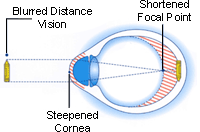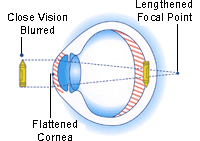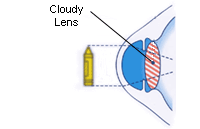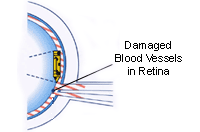Nearsightedness / Myopia

Farsightedness / Hyperopia

Astigmatism

Cataracts

Glaucoma

Diabetic Retinopathy

Resources
We hope you find the following information helpful.
Nearsightedness
Also known as Myopia, causes poor distance vision. If your eye is too long (front to back), or if your cornea has too much focusing power, images focus in front of the retina.
Farsightedness
Also known as Hyperopia, is the opposite of Myopia. Distant objects are clear and close up objects appear blurry. This condition is the result of an eye that is too short, or a cornea that lacks the necessary refractive power to focus on the retina.
Astigmatism
Astigmatism is a condition which blurs and distorts both distant and near objects. An astigmatic cornea has a different curvature from side to side and top to bottom.
Cataracts
A cataract is a cloudy or opaque area in the normally transparent lens of the eye. As the opacity thickens, it prevents light rays from passing through the lens and focusing on the retina, the light-sensitive tissue lining the back of the eye. Early lens changes or opacities may not disturb vision. But as the lens continues to change, several specific symptoms may develop, including blurred vision, sensitivity to light and glare, increased nearsightedness, or distorted images in either eye.
Glaucoma
Glaucoma is a specific pattern of optic nerve damage and visual field loss caused by a number of different eye diseases which can affect the eye. Most, but not all of these diseases are characterized by elevated intraocular pressure, which is not the disease itself, but the most important risk factor for the development of Glaucoma.
Diabetic Retinopathy
Anyone with diabetes is at risk to develop Diabetic Retinopathy. High blood sugar associated with diabetes can damage blood vessels in the retina causing deposits to form blind spots and floaters in the field of vision. Early symptoms of Diabetic Retinopathy include double vision and difficulty reading or doing close work.
Please note that the absence of symptoms does not completely rule out the presence of these conditions and diseases. This information should not be used for self-diagnosis. Only an examination by your eye doctor can verify the absence or presence of these conditons and diseases.